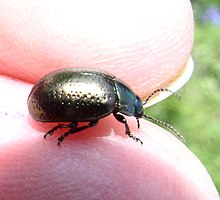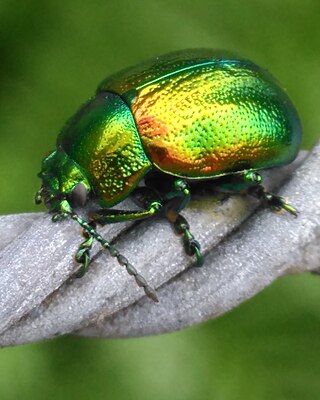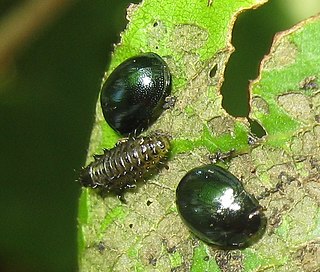- Allochrysolina Bechyně, 1950
- AllohypericiaBechyně, 1950
- AnopachysMotschulsky, 1860
- ApterosomaMotschulsky, 1860
- ArctolinaKontkanen, 1959
- AtechnaChevrolat, 1836
- AtlasianaBourdonne & Doguet, 1991
- BechyniaBourdonne, 1977
- BittotaeniaMotschulsky, 1860
- CecchiniolaJacobson, 1908
- CentopteraMotschulsky, 1860
- ChalcoideaMotschulsky, 1860
- ChersomelaWeise, 1914
- ChrysocrositaBechyně, 1950
- ChrysolinaMotschulsky, 1860
- ChrysolinopsisBechyné, 1950
- Chrysomorpha Motschulsky, 1860
- Colaphodes Motschulsky, 1860
- ColaphopteraMotschulsky, 1860
- Colaphosoma Motschulsky, 1860
- CrositopsMarseul, 1883
- CyrtochrysolinaKippenberg in Kippenberg & Döberl, 1994
- DiachalcoideaBechyné, 1955
- ErythrochrysaBechyně, 1950
- EuchrysolinaBechyně, 1950
- GhesquiereitaBechyně, 1950
- GnathomelaJacobson, 1895
- HeliostolaMotschulsky, 1860
- HypericiaBedel, 1898
- HypochalcoideaBourdonne, 2012
- JeanclaudiaMikhailov, 2009
- LiomelaWeise, 1912
- LithopteroidesStrand, 1935
- LopatinicaKippenberg, 2012
- MaenadochrysaBechyně, 1950
- MedvedevlevnaÖzdikmen, 2008
- MelasomopteraBechyně, 1950
- NaluhiaBechyné, 1948
- OmolinaWeise in Sjöstedt, 1909
- OvosomaMotschulsky, 1860
- OvostomaMotschulsky, 1860
- PalaeostictaBechyné, 1952
- ParacrositaDaccordi, 1982
- ParamenthastriellaDaccordi, 1980
- PezocrositaJacobson, 1901
- PierryvettiaBechyně, 1950
- PleurostichaMotschulsky, 1860
- PolystictellaBechyné, 1952
- PseudocrositaLopatin, 1999
- PseudolithopteraMedvedev, 1970
- PseudotimarchomimaDaccordi, 1980
- RhyssolomaWollaston, 1854
- SemenowiaWeise, 1889
- SibiriellaMedvedev, 1999
- SphaerochrysolinaKippenberg, 2010
- Sphaeromela Bedel, 1901
- StichopteraMotschulsky, 1860
- SulcicollisSahlberg, 1913
- SynergaWeise, 1900
- TaeniochryseaBechyně, 1950
- TaeniostichaMotschulsky, 1860
- ThrenosomaMotschulsky, 1860
- TimarchidaGanglbauer, 1897
- TimarcholinaBechyně, 1950
- TimarchomelaAchard, 1922
- TimarchopteraMotschulsky, 1860
- UpseleatlasiaBourdonne, 2012
- VittatochrysaLopatin, 1977
- ZeugotaeniaMotschulsky, 1860
|
- AltailinaMikhailov, 2000
- AnapachysMotschulsky, 1860
- BechyneaMedvedev, 1966
- BourdonneanaKippenberg in Löbl & Danilevsky, 2010
- CamerouniaJolivet, 1949
- CaudatochrysaBechyně, 1950
- ChesomelaWeise, 1918
- CobosorinaDavid, 1953
- ColophodesMotschulsky, 1860
- CraspedaMotschulsky, 1860
- DlochrysaMotschulsky, 1860
- DrochrysaKimoto, 1964
- GhesquièreitaBechyně, 1950
- GhesquieritaBechyně, 1950
- GhesquièritaBechyně, 1950
- HoplosomaMotschulsky, 1860
- JacobsoniaMedvedev, 1970
- LithopteraMotschulsky, 1860
- LitoptheroidesBechyne, 1950
- MenthastriellaBechyně, 1950
- MimophaedonBourdonne, 1996
- MinckiaStrand, 1935
- OreinaMonros & Bechyne, 1956
- OvomorphaMotschulsky, 1860
- PachygnathaWeise, 1892
- PalaeostrictaSeeno, 1976
- ParadiachalcoidaDaccordi, 1978
- ParadiachalcoideaDaccordi, 1978
- ParkaniolaBechyně, 1950
- PirryvittiaKimoto, 1964
- PolystichaGressitt & Kimoto, 1963
- PolystictaHope, 1840
- PseudotaeniochryseaDaccordi, 1980
- StichosomaMotschulsky, 1860
- TimarchomimaBechyně, 1950
|

















